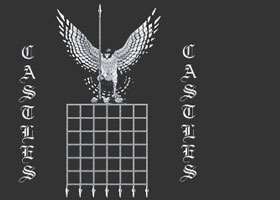Medieval Food Preservation
There were no methods available to freeze foods so Medieval food varied according to the season. It was not economic to feed animal during the winter therefore animals were slaughtered in the autumn and preserved in salt. The problem was that food had a constant salt taste. Methods were introduced to disguise the salty taste. Spices were added to recipes. These spices included pepper, mustard, saffron, cloves, cardimon and cinnamon. Medieval food was also served with a variety of sauces which also disguised the salty taste. Sugar was not available so honey was used in many Medieval recipes as this was the only sweetener available. Medieval Food and Drink - Convenience Food?
Did people in the Medieval era have convenience food? Yes! Biscuits were invented by the Crusaders. The 'Ploughman's Lunch' of bread and cheese was a staple diet of workers. Communal ovens were available in villages for baking. And pastries and pies were sold as was ready cooked roasted meat! Medieval Drink
Water was not clean in the Middle Ages and people therefore drank wine and ale. The rich drank both and the poor just drank ale. Honey was used to make a sweet alcoholic drink called mead which was drunk by all classes. Wine was generally imported although some fruit wines were produced in England. A form of cider referred to as 'Apple-wine' was also produced. Medieval Food and Drink - Fasting
People of the Medieval era were highly religious and at certain times the eating of meat was banned. This was not an occasional ban. Certain religious observances banned the eating of meat on Mondays, Wednesdays and Fridays! Meat was banned during the religious seasons of Lent and Advent. Meat was also declined on the eves of many religious holidays. Fasting and abstaining from eating meat was practised for over half the days in the year! Medieval Food and Drink The Black Death and Medieval Food and Drink
The amount of food and drink available in the Medieval world changed in 1328. The Black Death spread across Europe and the Western world. And the population dropped - the Black Death claimed a third of the World's population and 200 million people died. The Black Death reached England by 1346 and ravaged the land for nearly 60 years. The Black Death resulted in a far smaller population, more food was available and even the poor were able to eat meat. Medieval Food and Drink Medieval Food and Drink - A Balanced diet?
Did Medieval food and drink constitute a good balanced diet? No! And especially not for the rich! The rich ate few fresh vegetables and little fresh fruit - unprepared food of this variety was viewed with some suspicion! Fruit was usually served in pies or was preserved in honey. Vegetables and fresh fruit were eaten by the poor - vegetables would have been included in some form of stew, soup or pottage. Little was known about nutrition and the Medieval diet of the rich Nobles lacked Vitamin C and fibre. This led to an assortment of health problems including bad teeth, skin diseases, scurvy and rickets! Medieval Food and Drink Medieval Food and Drink
The information and facts surrounding Medieval food and drink are fascinating! | 
